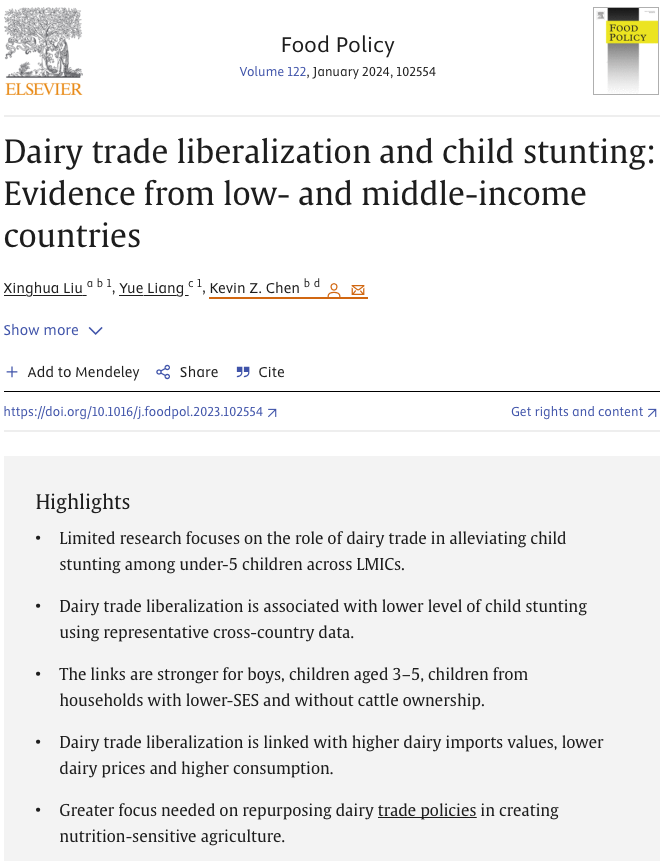近日,浙江大学中国农村发展研究院国际院长陈志钢教授和博士后刘星华与浙江外国语学院讲师梁越合作论文“Dairy trade liberalization and child stunting: Evidence from low- and middle-income countries”在期刊Food Policy在线发表。Food Policy是食品政策领域的顶级学术期刊,同时位于经济学大类、农业经济与政策领域、营养和膳食领域以及食品科学与技术领域Q1区,最新影响因子6.5。
全文引用:
Liu, X., Liang, Y., & Chen, K. Z. (2024). Dairy trade liberalization and child stunting: Evidence from low- and middle-income countries. Food Policy, 122, 102554. https://doi.org/https://doi.org/10.1016/j.foodpol.2023.102554

中文摘要
大量研究表明乳制品消费对缓解儿童生长发育迟缓具有积极作用。中低收入国家具有较高的儿童发育迟缓发生率和较低的乳制品消费水平。已有研究表明,较高的乳制品价格是限制这些国家增加乳制品消费的一大因素。鲜有研究关注乳制品贸易政策,特别是乳制品贸易自由化与中低收入国家儿童发育迟缓之间关系。为此,本研究使用2006年至2020年跨国数据,并将其与国家层面乳制品贸易数据相匹配。研究发现,乳制品关税税率下降10%可将发育迟缓的风险降低7.78%。去除2000年之后加入世贸组织的国家样本和使用其他聚类方法结果均稳健。安慰剂检验表明,儿童发育迟缓与咖啡和茶的关税水平无关。异质性分析发现,这一关系对男孩、3-5岁儿童和来自低社会经济地位家庭的儿童更为明显。同时,这一关系较强地体现于没有养牛家庭以及来自西非、东南亚、欧洲和中亚的家庭。然而本研究没有发现显著的农村和城市差异。机制分析表明,乳制品关税与乳制品价格正相关,而与乳制品进口价值负相关。研究还发现,较低的乳制品关税与较高的儿童乳制品消费概率有关。本文强调了消除关税壁垒对降低乳制品成本和促进中低收入国家乳制品消费的重要性。这项研究对重新调整乳制品贸易政策以发展营养敏感型农业具有启示意义。
英文摘要
Despite the well-studied nutritional benefits of dairy for child linear growth, dairy is less consumed in low- and middle-income countries (LMICs) where the prevalence of child stunting is high. Previous studies have suggested the cost of dairy as a potential barrier to increased dairy consumption in these countries. Surprisingly, little research on the association between dairy consumption and child stunting in LMICs focuses on the role of trade policies, particularly the liberalization of dairy trade. To explore this, we use representative cross-country individual data on child stunting from 2006 to 2020 and link it with country-level dairy trade data. We find that a 10% decline in dairy tariff rates reduces the risk of stunting by 7.78%. Our results are robust to a subsample analysis excluding countries which joined the WTO after 2000 and to an alternative clustering method. As a falsification test, our results show child stunting is not linked with tariffs for coffee and tea. Heterogeneity analysis indicates the associations are more pronounced for boys, children aged 3–5, and children from households with lower socioeconomic status. Although we did not find significant rural–urban differences, the associations are indeed stronger for households without cattle and for countries in Western Africa, South East Asia and Europe and Central Asia. Mechanism analysis suggests that dairy tariffs are positively correlated with milk prices, while they are negatively associated with dairy import values. Lower dairy tariffs are also found to be linked with higher probability of child dairy consumption. Our findings highlight the importance of removing tariff barriers in reducing the cost of dairy and promoting dairy consumption in LMICs. This study has implications for repurposing dairy trade policies in creating nutrition-sensitive agriculture.


